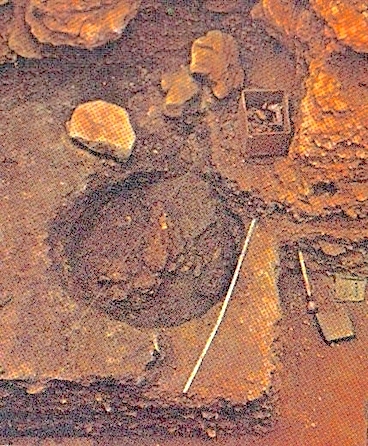Museum of the Origins of Man
THE ORIGIN OF PALEOLITHIC FUNERARY ARCHITECTURE

Fig. 25.1) Burial pit of a very young Neanderthal boy from the Lower Mousterian (Middle Paleolithic) at Combe-Grenal site in Dordogne, France. The three stones that were placed on the small corpse are visible. The Paleolithic funerary architecture is little known to us. However, since burial of the deceased began in a sleeping position, the phases ascertained are these:
1°) The hole in the ground;
2°) The hole in the ground covered with stone slabs;
3°) The hole in the ground with a small square or rectangular burial place, box-shaped and this is what has been found in the Upper Paleolithic to date
In post-Paleolithic times, in addition to burials in the ground, the raising of architecture above the ground begins. The first tombs of this type are the dolmens.
Funerary architecture was greatly enriched all over the world by the contribution of working techniques used for sculpting stone.
It was either rupestrian, i.e. carved into rock, or made of squared monoliths as in the construction of the pyramids. In forest regions, wood was used.
NEXT
Index
HOME PAGE
Page translated from Italian into English by Paris Alexander Walker.
Copyright©2020 by Museum of the Origins of the Man, all rights reserved. 
